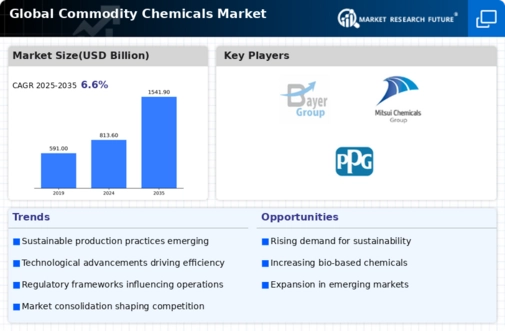Market Analysis
In-depth Analysis of Commodity Chemicals Market Industry Landscape
The commodity chemicals industry operates under complex dynamics governed by several factors, which include the supply-demand-price relationship. Commodity chemicals or bulk chemicals form the building blocks for many industries, providing basic raw materials for various things. Globally, Economic conditions directly impact demand for these chemicals, which is among the key drivers behind the cyclical behavior they experience. Economic growth rates, industrial activities, and inflation levels all have a direct influence over demand-side forces within this sector. During times of economic growth, firms tend to produce at an elevated scale, hence necessitating more inputs such as chemicals. In contrast, a decline in the economy generally causes a reduction in demand as industries cut back on their operations. Additionally, geopolitical factors have also shaped market dynamics related to commodity chemicals. Trade wars, political tensions, and changes in policy may disrupt global supply chains, affecting the production and distribution of these chemicals. Tariffs, sanctions, or trade deals may introduce uncertainties that affect pricing arrangements and behaviors. Technological advancements have greatly influenced the development of the commodity chemical sector. This encompasses improvements within manufacturing processes, automation, and sustainable developments that impact both sides of the supply chain. Enhancing production processes can lead to cost efficiencies, hence changing pricing dynamics, while eco-friendly technologies help address concerns over sustainability and regulatory compliance. Therefore, environmental considerations are increasingly important for the dynamics of the market of commodity chemicals. This industry is being pushed towards environmentally friendly practices by regulations and customer preferences that are becoming more focused on sustainability. Moreover, volatility in the market for these commodities also arises from supply chain disruptions, natural disasters, and other unforeseen occurrences. Besides industry-driven forces, market dynamics are influenced by the cyclic nature of some industries that rely heavily on commodity chemicals, such as construction and automotive. For instance, there are cyclical booms and slowdowns experienced in sectors like construction and automotive, which directly affect demand for chemicals used in manufacturing processes. Consequently, understanding these cycles would enable stakeholders in this field to make informed choices and adjust their operations depending on prevailing economic circumstances.







Leave a Comment